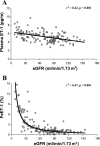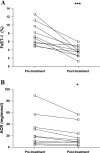Urinary endothelin-1 in chronic kidney disease and as a marker of disease activity in lupus nephritis
- PMID: 19279127
- PMCID: PMC2692450
- DOI: 10.1152/ajprenal.90713.2008
Urinary endothelin-1 in chronic kidney disease and as a marker of disease activity in lupus nephritis
Abstract
Chronic inflammation contributes to the development and progression of chronic kidney disease (CKD). Identifying renal inflammation early is important. There are currently no specific markers of renal inflammation. Endothelin-1 (ET-1) is implicated in the pathogenesis of CKD. Thus, we investigated the impact of progressive renal dysfunction and renal inflammation on plasma and urinary ET-1 concentrations. In a prospective study, plasma and urinary ET-1 were measured in 132 subjects with CKD stages 1 to 5, and fractional excretion of ET-1 (FeET-1) was calculated. FeET-1, serum C-reactive protein (CRP), urinary ET-1:creatinine ratio, and urinary albumin:creatinine ratio were also measured in 29 healthy volunteers, 85 subjects with different degrees of inflammatory renal disease but normal renal function, and in 10 subjects with rheumatoid arthritis without renal involvement (RA). In subjects with nephritis associated with systemic lupus erythematosus (SLE), measurements were done before and after 6 mo of treatment. In subjects with CKD, plasma ET-1 increased linearly as renal function declined, whereas FeET-1 rose exponentially. In subjects with normal renal function, FeET-1 and urinary ET-1:creatinine ratio were higher in SLE subjects than in other groups (7.7 +/- 2.7%, 10.0 +/- 3.0 pg/mumol, both P < 0.001), and correlated with CRP, and significantly higher than in RA subjects (both P < 0.01) with similar CRP concentrations. In SLE patients, following treatment, FeET-1 fell to 3.6 +/- 1.4% (P < 0.01). Renal ET-1 production increases as renal function declines. In subjects with SLE, urinary ET-1 may be a useful measure of renal inflammatory disease activity while measured renal function is still normal.
Figures



References
-
- Benigni A, Corna D, Zoja C, Longaretti L, Gagliardini E, Perico N, Coffman TM, Remuzzi G. Targeted deletion of angiotensin II type 1A receptor does not protect mice from progressive nephropathy of overload proteinuria. J Am Soc Nephrol 15: 2666–2674, 2004. - PubMed
-
- Benigni A, Perico N, Gaspari F, Zoja C, Bellizzi M, Gabanelli M, Remuzzi G. Increased renal endothelin production in rats with reduced renal mass. Am J Physiol Renal Fluid Electrolyte Physiol 260: F331–F339, 1991. - PubMed
-
- Benigni A, Zoja C, Corna D, Orisio S, Longaretti L, Bertani T, Remuzzi G. A specific endothelin subtype A receptor antagonist protects against injury in renal disease progression. Kidney Int 44: 440–444, 1993. - PubMed
Publication types
MeSH terms
Substances
Grants and funding
LinkOut - more resources
Full Text Sources
Other Literature Sources
Medical
Molecular Biology Databases
Research Materials
Miscellaneous

